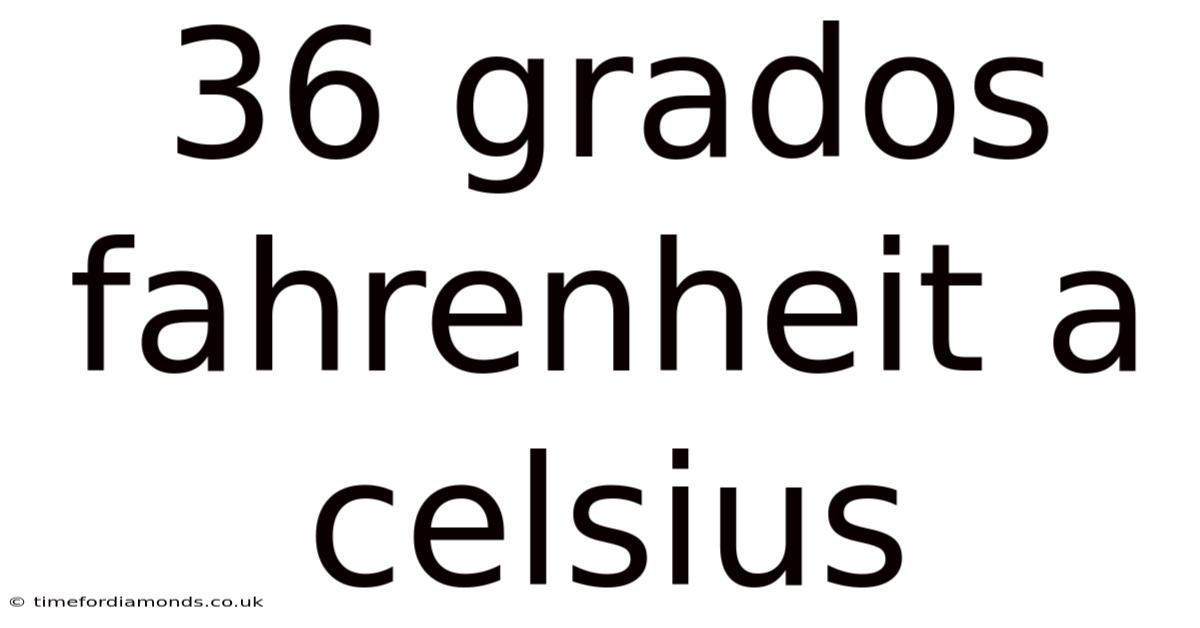36 Grados Fahrenheit A Celsius
timefordiamonds
Sep 24, 2025 · 5 min read

Table of Contents
36 Degrees Fahrenheit to Celsius: A Comprehensive Guide
Converting temperatures between Fahrenheit and Celsius is a common task, especially for those working in scientific fields or dealing with international weather reports. This article will comprehensively explain how to convert 36 degrees Fahrenheit (°F) to Celsius (°C), providing various methods, underlying scientific principles, and addressing frequently asked questions. Understanding this conversion is crucial for accurate temperature interpretation and application across different contexts. We'll explore the formula, practical applications, and even delve into the history behind these temperature scales.
Understanding Temperature Scales: Fahrenheit vs. Celsius
Before diving into the conversion, let's briefly review the two scales:
-
Fahrenheit (°F): Developed by Daniel Gabriel Fahrenheit in the early 18th century, this scale sets the freezing point of water at 32°F and the boiling point at 212°F, at standard atmospheric pressure.
-
Celsius (°C): Also known as the centigrade scale, it was developed by Anders Celsius. It defines the freezing point of water at 0°C and the boiling point at 100°C, again at standard atmospheric pressure.
Converting 36°F to Celsius: The Formula and Calculation
The most straightforward method for converting Fahrenheit to Celsius is using the following formula:
°C = (°F - 32) × 5/9
Let's apply this formula to convert 36°F:
-
Subtract 32 from the Fahrenheit temperature: 36°F - 32 = 4°F
-
Multiply the result by 5/9: 4°F × 5/9 ≈ 2.22°C
Therefore, 36°F is approximately equal to 2.22°C.
Practical Applications of Temperature Conversion
Accurate temperature conversion is vital in numerous situations:
-
International Communication: Weather reports, scientific publications, and global collaborations often require consistent temperature units. Converting between Fahrenheit and Celsius ensures clear communication regardless of location or audience.
-
Medical Applications: Body temperature is a critical health indicator. Medical professionals need to accurately convert temperatures between scales for diagnosis and treatment. A temperature of 36°F (2.22°C) is significantly below the normal human body temperature, indicating hypothermia.
-
Food Safety: Maintaining appropriate food temperatures is essential to prevent bacterial growth and foodborne illnesses. Recipes and food safety guidelines might use either Fahrenheit or Celsius, requiring accurate conversion for proper preparation and storage.
-
Industrial Processes: Many industrial processes, like manufacturing and chemical engineering, require precise temperature control. Conversion between Fahrenheit and Celsius ensures accurate monitoring and adjustment.
-
Climate Science: Analyzing global temperature data often involves converting between different temperature units for comprehensive comparison and analysis.
The Scientific Basis of Temperature Conversion
The conversion formula is derived from the relationship between the freezing and boiling points of water in both scales. The formula's structure reflects the difference in the scale's intervals:
-
The subtraction of 32: This accounts for the offset in the freezing point between the two scales (32°F vs. 0°C).
-
Multiplication by 5/9: This adjusts for the different sizes of the degree intervals. One degree Celsius is larger than one degree Fahrenheit (a 1°C change is equivalent to a 9/5°F change).
This conversion is a linear transformation, implying a consistent proportional relationship between Fahrenheit and Celsius values across the entire temperature range.
Alternative Methods for Conversion
While the formula provides the most accurate calculation, other methods can be used for quick estimations:
-
Using Online Converters: Numerous online calculators and conversion tools readily convert between Fahrenheit and Celsius. These are convenient for quick conversions but lack the educational value of understanding the underlying formula.
-
Approximation: For rough estimates, remember that 0°C is approximately 32°F. Each degree Celsius is roughly equivalent to 1.8 degrees Fahrenheit. This approximation is useful for quick mental calculations, though it lacks precision.
Frequently Asked Questions (FAQ)
Q1: Is 36°F a dangerously low temperature?
A1: Yes, 36°F (2.22°C) is significantly below the normal human body temperature, which is around 98.6°F (37°C). Such a low temperature indicates severe hypothermia and requires immediate medical attention.
Q2: Can I use this formula for any Fahrenheit to Celsius conversion?
A2: Yes, the formula (°C = (°F - 32) × 5/9) applies to all Fahrenheit-to-Celsius conversions.
Q3: Why are there two different temperature scales?
A3: Historically, different scales emerged independently. The Fahrenheit scale was developed earlier and gained popularity in certain regions, while the Celsius scale gained widespread adoption due to its logical structure based on the freezing and boiling points of water. The Celsius scale, based on the metric system, is now the more internationally preferred scale for scientific and most general applications.
Q4: Are there other temperature scales besides Fahrenheit and Celsius?
A4: Yes, there are other scales, including Kelvin (K), which is an absolute temperature scale used extensively in science and engineering.
Q5: What is the significance of standard atmospheric pressure in defining freezing and boiling points?
A5: The freezing and boiling points of water are dependent on pressure. Standard atmospheric pressure (typically defined as 101.325 kPa) is used as a reference point for defining these critical temperatures in both Celsius and Fahrenheit scales, providing a consistent benchmark for comparisons.
Conclusion
Converting 36°F to Celsius, yielding approximately 2.22°C, is a straightforward process using a simple formula. Understanding this conversion is crucial for various practical applications and highlights the importance of having a firm grasp on the relationship between these two common temperature scales. This knowledge is not only useful for everyday tasks but also essential for understanding and interpreting data across different disciplines and cultures. The formula's derivation, based on the fundamental properties of water, provides a deeper understanding of the scientific principles behind temperature measurement and conversion. Remember to always prioritize accuracy when working with temperature conversions, particularly in fields where precision is critical.
Latest Posts
Related Post
Thank you for visiting our website which covers about 36 Grados Fahrenheit A Celsius . We hope the information provided has been useful to you. Feel free to contact us if you have any questions or need further assistance. See you next time and don't miss to bookmark.